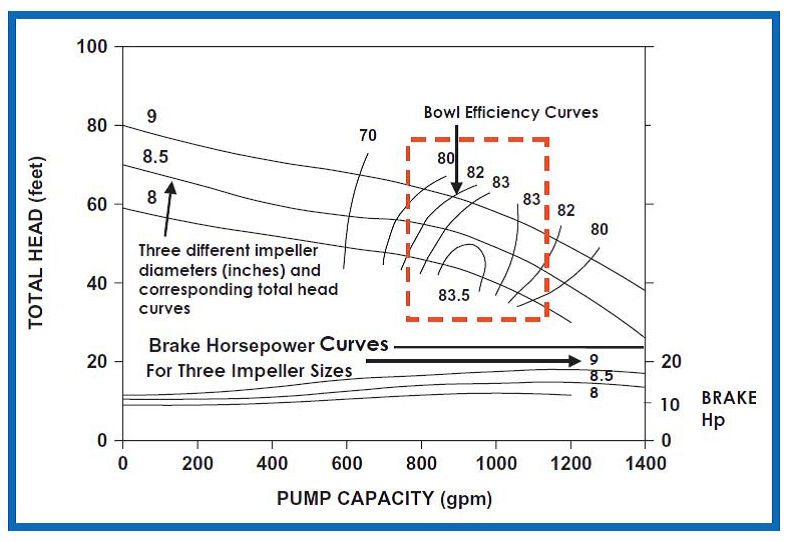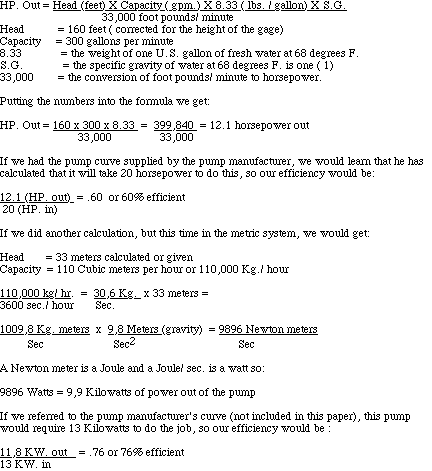Navigation
Install the app
How to install the app on iOS
Follow along with the video below to see how to install our site as a web app on your home screen.
Note: This feature may not be available in some browsers.
More options
Style variation
-
Congratulations TugboatEng on being selected by the Eng-Tips community for having the most helpful posts in the forums last week. Way to Go!
You are using an out of date browser. It may not display this or other websites correctly.
You should upgrade or use an alternative browser.
You should upgrade or use an alternative browser.
Pump VS Bowl Efficiency 1
- Thread starter nicwong7
- Start date
- Status
- Not open for further replies.
-
1
- #2
Bowl efficiency is typically quoted on vertical turbine type pumps like a VS1 type.
It is the efficiency attained by the pump when measured immediately after the final pump stage.
The pump efficiency is the efficiency of the pump when measured at the discharge flange of the pump.
In the case of a vertical turbine type pump which may have hundreds or even thousands of feet of column pipe (between the pump final stage and the discharge flange), there can be large differences between the two values. Hence it makes sense to quote the bowl efficiency as this value does not change with pump column pipe length and allows easy comparison of different pump suppliers.
It is the efficiency attained by the pump when measured immediately after the final pump stage.
The pump efficiency is the efficiency of the pump when measured at the discharge flange of the pump.
In the case of a vertical turbine type pump which may have hundreds or even thousands of feet of column pipe (between the pump final stage and the discharge flange), there can be large differences between the two values. Hence it makes sense to quote the bowl efficiency as this value does not change with pump column pipe length and allows easy comparison of different pump suppliers.
For a VS6 (suction and discharge are at same elevation) the only difference is losses in the column and barrel, maybe a few tenths of a percent because the vendor is being conservative.
For a VS1, the elevation difference between the water level and the discharge flange needs to be considered, and it is factored into the pump efficiency. It is very important to establish pump vs bowl efficiency and performance for a VS1, because what you get at the flange depends on the water level.
Basically, the pump efficiency (what you get out of the discharge flange) is penalized based on the elevation difference. If you need 100ft of head at the flange, but the flange is 100 ft above the water level, then your required bowl performance is 200 ft, your pump performance is 100 ft, in an ideal case, the highest pump efficiency would be 50%.
It's a bad deal, always use bowl performance when working with a VS1. Takes a little bit of simple math to know what's happening, but avoids all the confusion and potential errors in pump selection. I've seen selections off by the elevation difference, off by the difference between high and low water levels, and customers who thought they were getting bowl performance/efficiency out of the flange.
For a VS1, the elevation difference between the water level and the discharge flange needs to be considered, and it is factored into the pump efficiency. It is very important to establish pump vs bowl efficiency and performance for a VS1, because what you get at the flange depends on the water level.
Basically, the pump efficiency (what you get out of the discharge flange) is penalized based on the elevation difference. If you need 100ft of head at the flange, but the flange is 100 ft above the water level, then your required bowl performance is 200 ft, your pump performance is 100 ft, in an ideal case, the highest pump efficiency would be 50%.
It's a bad deal, always use bowl performance when working with a VS1. Takes a little bit of simple math to know what's happening, but avoids all the confusion and potential errors in pump selection. I've seen selections off by the elevation difference, off by the difference between high and low water levels, and customers who thought they were getting bowl performance/efficiency out of the flange.
Typically a VTP manufacturer will post the efficiency/HP losses occurring between the top bowl and the discharge flange. These can be used to size motor.
Most of the losses are in the column section and are dependent upon configuration (open or closed lineshaft) as well as the column and lineshaft diameters, and bearing retainers.
Most of the losses are in the column section and are dependent upon configuration (open or closed lineshaft) as well as the column and lineshaft diameters, and bearing retainers.
Some comments above are dead wrong and very misleading. Lift does not effect efficiency, because you reference to a common datum. Go to any hydraulic reference, and look at how total head is defined.
With bowl head, you measure pressure right at the bowl discharge. With pump head, you measure pressure at the discharge flange.
With a VS1, the loss in pressure head you get because you are measuring higher on the pump is exactly made up for the by the GAIN in lift, which is part of the head calculation. The difference between pump head and bowl head is the friction between the bowl pressure measurement location, and discharge flange measurement location. That is all...
VS6 pumps tend to be higher pressure, which is why the difference between bowl head and pump head is smaller. Wet pit pumps can have very low heads (High Ns pumps) and the effect of friction losses is proportionally much greater.
Scary some of the stuff that gets posted here...
With bowl head, you measure pressure right at the bowl discharge. With pump head, you measure pressure at the discharge flange.
With a VS1, the loss in pressure head you get because you are measuring higher on the pump is exactly made up for the by the GAIN in lift, which is part of the head calculation. The difference between pump head and bowl head is the friction between the bowl pressure measurement location, and discharge flange measurement location. That is all...
VS6 pumps tend to be higher pressure, which is why the difference between bowl head and pump head is smaller. Wet pit pumps can have very low heads (High Ns pumps) and the effect of friction losses is proportionally much greater.
Scary some of the stuff that gets posted here...
Pump efficiency is a measure of how much water horsepower is produced by the pumping plant from the input horsepower. It is the combination of three efficiencies:
1) Bowl efficiency - the efficiency of the pump itself.
2) Driver efficiency - the efficiency of the electric motor or engine.
3) Transmission efficiency - a measure of losses that occur in transmission shafts, chains, pulleys, and v-belts.
Pump curves provide three important performance relationships in one graph:
1) the relationship between pump capacity (gpm) and total head capacity to lift and pressurize water expressed in feet);
2) the relationship between pump capacity (gpm) and bowl efficiency (%); and
3) the relationship between pump capacity and brake (shaft) horsepower.
A pump performance curve shows a range of conditions where a pump can be expected to perform efficiently. The bowl efficiency of a pump can be expected to decrease if operated outside these parameters or as it wears.

Published pump performance curve with bowl efficiency, required pump input power and required net positive suction head.
For centrifugal pumps, the pump efficiency is the amount of work or power out of the pump compared to the amount of power put into the pump. As an example: HP out of the pump/ HP into the Pump.
Flow = gallons per minute of water as measured coming from the pump discharge.
Head = Measured at the discharge side of the pump. Negative suction heads are added to the pump discharge head, positive suctions heads are subtracted from the pump discharge head.

1) Bowl efficiency - the efficiency of the pump itself.
2) Driver efficiency - the efficiency of the electric motor or engine.
3) Transmission efficiency - a measure of losses that occur in transmission shafts, chains, pulleys, and v-belts.
Pump curves provide three important performance relationships in one graph:
1) the relationship between pump capacity (gpm) and total head capacity to lift and pressurize water expressed in feet);
2) the relationship between pump capacity (gpm) and bowl efficiency (%); and
3) the relationship between pump capacity and brake (shaft) horsepower.
A pump performance curve shows a range of conditions where a pump can be expected to perform efficiently. The bowl efficiency of a pump can be expected to decrease if operated outside these parameters or as it wears.

Published pump performance curve with bowl efficiency, required pump input power and required net positive suction head.
For centrifugal pumps, the pump efficiency is the amount of work or power out of the pump compared to the amount of power put into the pump. As an example: HP out of the pump/ HP into the Pump.
Flow = gallons per minute of water as measured coming from the pump discharge.
Head = Measured at the discharge side of the pump. Negative suction heads are added to the pump discharge head, positive suctions heads are subtracted from the pump discharge head.

- Status
- Not open for further replies.
Similar threads
- Replies
- 12
- Views
- 940
